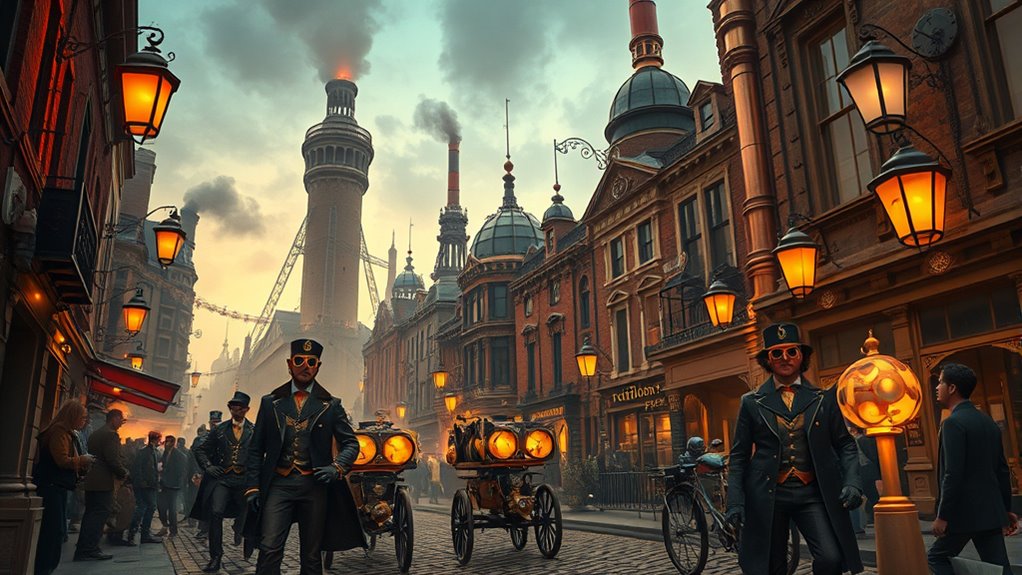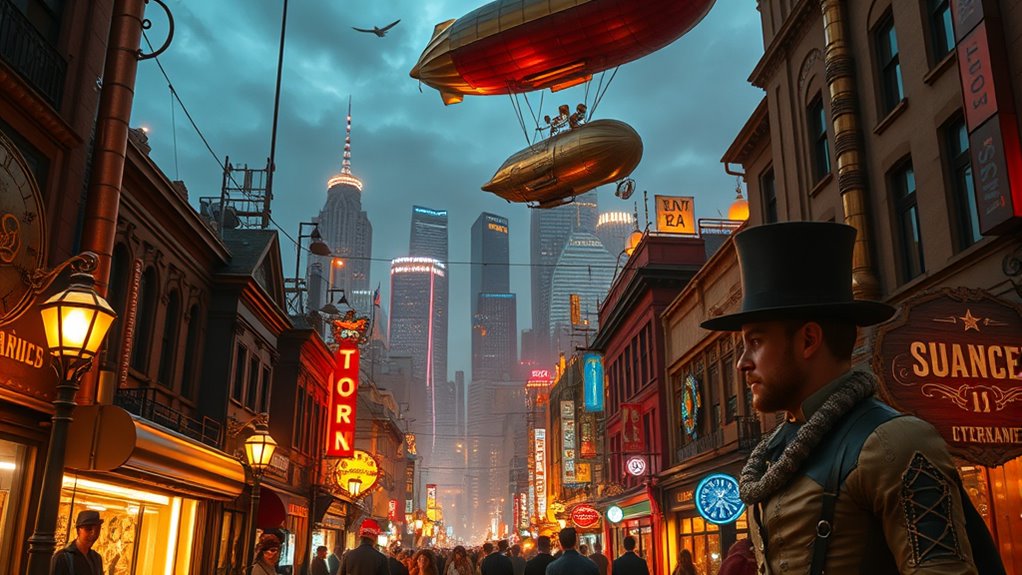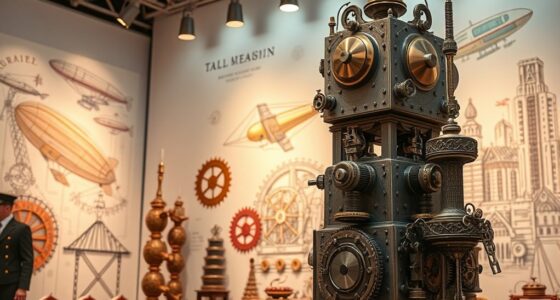In the 2020s, steampunk is experiencing a lively revival that blends Victorian style with modern technology and inclusivity. You’ll see this shift across fashion, art, and innovation, where intricate designs meet 3D printing, AR, and sustainable materials. This movement isn’t just about nostalgia; it’s about redefining the genre for a diverse and creative community. Curious what new ideas are shaping this dynamic era? Keep exploring to uncover how the future of steampunk is unfolding.
Key Takeaways
- The 2020s steampunk revival blends Victorian aesthetics with modern technology like AR and 3D printing.
- It emphasizes inclusivity and innovation, expanding beyond traditional Victorian themes.
- Artists and creators incorporate sustainable materials and contemporary sensibilities into steampunk design.
- The movement encourages participation across fashion, art, storytelling, and tech communities.
- Steampunk’s evolution fosters a dynamic culture that bridges vintage charm with futuristic ideas.

Have you noticed how steampunk is experiencing a vibrant revival? It’s like stepping into a world where Victorian aesthetics and technological innovation collide to create something entirely new yet nostalgically familiar. This resurgence isn’t just a passing trend; it’s a movement that’s redefining what steampunk can be in the 2020s. You see it in fashion, art, literature, and even in tech communities that are embracing its blend of vintage charm and futuristic thinking. The key to this renaissance lies in how creators are reimagining the genre, making it more inclusive and adaptable while staying true to its roots.
Victorian aesthetics, with their intricate designs, lavish details, and a sense of grandeur, form the visual backbone of modern steampunk. But now, these elements are getting a fresh twist. Instead of strictly adhering to historical accuracy, artists and designers are playing with scale, color, and materials to craft unique, often whimsical interpretations. Think brass gears and leather corsets, but with a modern sensibility that appeals to contemporary tastes. This approach allows for greater freedom and innovation, giving enthusiasts a wide canvas to express their creativity. You might find a steampunk-inspired fashion line that combines Victorian elegance with sustainable fabrics or a piece of art that uses retro-futuristic motifs to comment on current social issues. The Victorian aesthetic serves as a foundation, but it’s no longer a cage—it’s a springboard for new ideas.
Technological innovation plays a *vital* role in this renaissance as well. While early steampunk celebrated the Victorian era’s mechanical ingenuity, today’s creators are pushing those ideas further. They blend old-world craftsmanship with modern technology, such as 3D printing, Arduino circuits, and augmented reality, to bring steampunk worlds to life. It’s not just about nostalgia anymore; it’s about harnessing the power of today’s tools to build immersive experiences and functional gadgets that look like they belong in a Jules Verne novel. This integration of tech and vintage design invites you to imagine a future where innovation isn’t just digital but also tactile and artistic. It’s about bridging the past and the present, making steampunk relevant for a new generation that craves both aesthetic beauty and technological progress.
In this renaissance, you’re encouraged to explore and create, whether through fashion, storytelling, or tech experiments. The genre’s revival isn’t confined to fandom; it’s inspiring entrepreneurs, artists, and hackers to forge new paths. By embracing Victorian aesthetics and technological innovation, the modern steampunk movement invites you to be part of a dynamic, evolving culture—one that honors history while boldly shaping its future. Additionally, the integration of financial management principles can help creators sustain their innovative projects and turn their passions into viable businesses.
Frequently Asked Questions
How Has Digital Technology Influenced Modern Steampunk Designs?
Digital innovation has transformed modern steampunk designs by enabling you to explore virtual aesthetics that blend retro-futuristic elements with digital art. You can incorporate 3D modeling, augmented reality, and interactive graphics, making your creations more dynamic and immersive. This integration allows for more detailed craftsmanship and personalized features, pushing the boundaries of traditional steampunk and inviting you to innovate within the genre like never before.
Are There Emerging Global Steampunk Communities Outside the Western World?
Did you know that over 15% of global steampunk enthusiasts now belong to non-Western communities? You’ll find vibrant, emerging global communities outside the Western world, especially in countries like India, China, and Brazil. These non-Western steampunk groups celebrate unique cultural influences, blending traditional elements with classic steampunk aesthetics. As a result, the genre’s becoming more diverse and inclusive, offering fresh perspectives and inspiring creativity worldwide.
What Are the Environmental Impacts of Steampunk Manufacturing Processes?
You might wonder about the environmental impacts of steampunk manufacturing. By using sustainable materials, you can minimize pollution and reduce waste, making the process more eco-friendly. Incorporating recycled metals and eco-conscious fabrics helps cut down on harmful emissions. When you choose pollution reduction strategies, you not only protect the environment but also promote a more responsible approach to creating steampunk gear, ensuring the genre’s growth doesn’t come at nature’s expense.
How Does Steampunk Intersect With Other Alternative History Genres?
You see that steampunk often intersects with other alternative history genres through genre blending, creating rich, imaginative worlds. It combines Victorian aesthetics with futuristic technology, paralleling genres like dieselpunk or clockpunk. This fusion allows you to explore different timelines, alternative societies, and technological advancements, making steampunk a versatile platform for storytelling. It’s the creative interplay between history and invention that makes steampunk uniquely engaging and endlessly adaptable.
What Role Do Cosplay and Conventions Play in the Renaissance?
Did you know that over 80% of steampunk enthusiasts attend cosplay events? Conventions are crucial for the renaissance, fueling cosplay creativity and inspiring new ideas. They provide a space for enthusiasts to showcase costumes, exchange ideas, and network with like-minded fans. These gatherings strengthen the community, celebrate the genre, and drive its evolution, making conventions essential in revitalizing and expanding the steampunk movement today.
Conclusion
As you plunge into this steampunk renaissance, you become part of a vibrant tapestry woven with gears, steam, and endless imagination. The genre’s revival is like a phoenix rising from its ashes, blending the old with the new in a dazzling dance of innovation. Embrace this whirlwind of creativity, where every clockwork detail sparks a new adventure. You’re not just observing history—you’re helping craft its steampunk future, one cog at a time.









